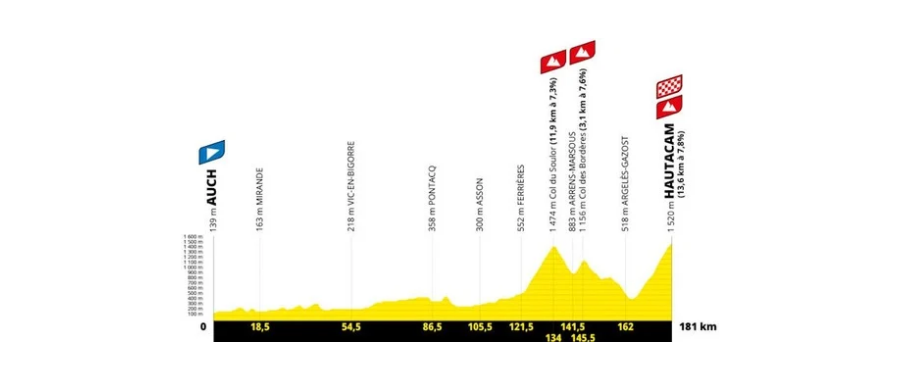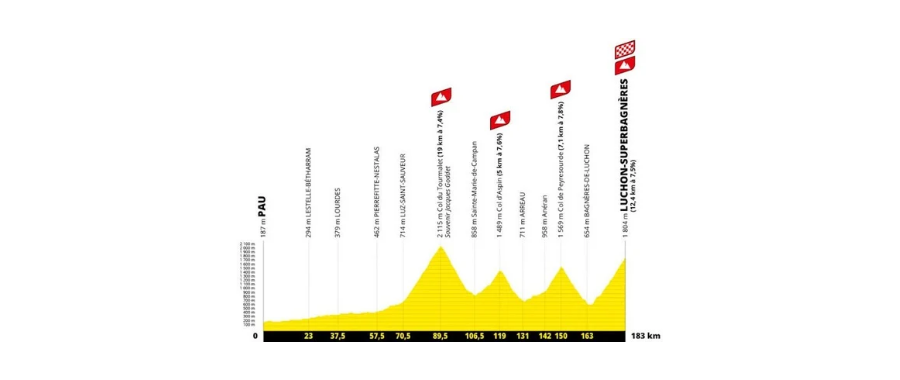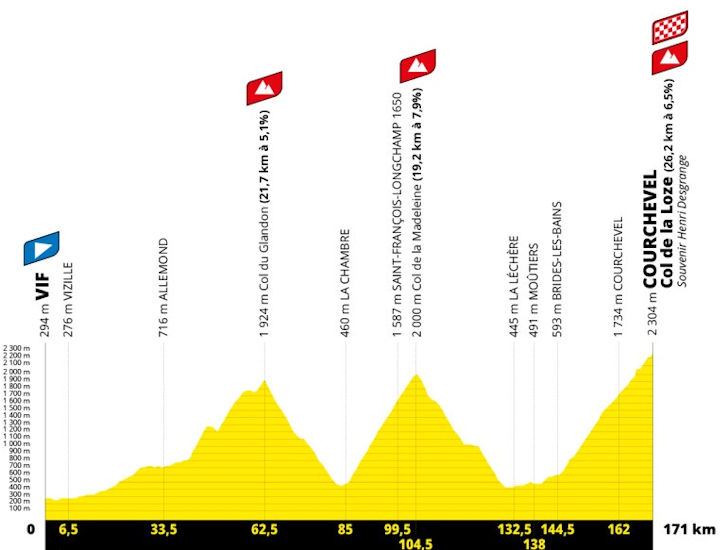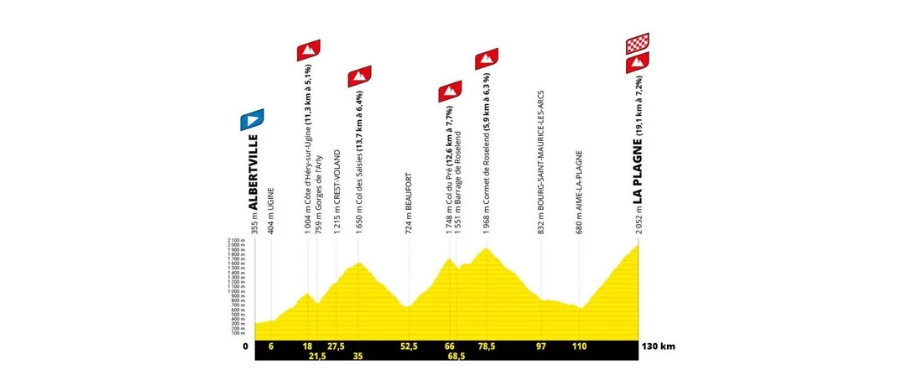The high mountains of the Tour de France are more than just physical challenges—they’re where cycling’s mythology is written. Since 2020, the sport has entered a new golden age of climbing: young champions, brutal gradients, and psychological warfare in the thin air. These are the moments where general classifications are decided, careers are defined, and the line between triumph and heartbreak becomes razor-thin.
Here are ten of the most unforgettable high-mountain moments from the 2020s, each etched into the recent lore of the Tour.
Col de la Loze’s brutal debut (202
The Tour’s introduction of the Col de la Loze wasn’t just symbolic—it was seismic. At 2,304 meters, this brutal, narrow, and oddly paved bike-only path felt like it belonged more to a fever dream than to a Grand Tour. The final 7 kilometers featured gradients so steep and inconsistent they bordered on cruel.
Miguel Ángel López took full advantage, timing his attack to perfection and soloing to a career-defining win. But the real drama lay in the silent duel between Roglič and Pogačar. Roglič held his ground, gaining a few seconds, looking indomitable. But beneath the surface, something was shifting—the Tour was far from over. The Loze didn't just test legs; it tested psyches.
Pogačar strikes on the Grand Colombier (2020)
On a sweltering day in the Jura Mountains, Tadej Pogačar announced himself not just as a prodigy, but as a cold-blooded contender. The Grand Colombier, with its three-pronged climb and punishing final ramp, was the stage where Pogačar first cracked the Jumbo-Visma armor.
In the final meters, he surged past Roglič in a clinical sprint—a statement made not with fire, but with ice. Behind them, defending champion Egan Bernal spectacularly cracked, losing over seven minutes and vanishing from the GC picture. For a race that had been defined by tactical control, this was a moment of chaos—and a glimpse of the reckoning to come in Paris.
Double blow: Col de Romme & Colombière (2021)
Rain lashed down as the peloton entered the first truly mountainous test of the 2021 Tour. Jumbo-Visma was already in tatters from earlier crashes, and UAE Team Emirates sensed blood. On the Col de Romme, Tadej Pogačar launched an attack that would change the race forever.
By the top of Colombière, he was alone, soaked to the bone, and riding as if possessed. He didn’t just gain time—he humiliated his rivals. Roglič lost minutes. Geraint Thomas faded. Pogačar grabbed the yellow jersey and never looked back. It wasn’t just a performance—it was a public execution on the slopes, and the beginning of a legend.
A day in Andorra: Port d’Envalira (2021)
Andorra has long been a home base for riders, but on this stage, it became a battlefield. The peloton crossed into the microstate and began a punishing march toward the Port d’Envalira—2,408 meters above sea level and the highest paved pass in the Pyrenees.
The thin air suffocated rhythm, the relentless gradients sapped morale. The breakaway—stacked with climbers like Sepp Kuss—duelled all day for survival, while the GC group shattered. Wout van Aert, improbably, paced Roglič and others for kilometers, reminding everyone that he was no ordinary rider. The day was less about time gaps than damage control—survival, attrition, and positioning for the final Alpine act.
Col du Granon Returns, and So Does Chaos (2022)
It had been 36 years since the Tour last visited the Col du Granon, but when it returned in 2022, it did so with vengeance. At over 2,400 meters, following the legendary Galibier and Télégraphe, Granon was a gauntlet thrown at every contender’s feet.
Pogačar cracked for the first time in two Tours. Jonas Vingegaard, backed by a brutal Jumbo-Visma offensive, attacked at the perfect moment and rode into yellow. The Slovenian was left isolated and reeling, losing almost three minutes. The race flipped upside down. In one of the most tactically daring team moves in years, Granon became not just a stage, but a symbol of a shifting era.
Pidcock Dances on Alpe d’Huez (2022)
Alpe d’Huez is hallowed ground. It’s where cycling gods are crowned, from Hinault to Pantani. In 2022, it became the stage for a new kind of victory—Tom Pidcock, just 22 years old and riding his first Tour, launched a spectacular descent off the Galibier and soloed up Alpe d’Huez like a veteran.
What made it extraordinary wasn’t just that he won—he owned the day. Pidcock’s daredevil descending, touching speeds over 100 km/h, put him clear of the break. On the iconic 21 hairpins of Alpe d’Huez, with the Dutch Corner roaring and Bastille Day fireworks metaphorically in the air, he kept the gap steady and controlled the chase behind.
As he crossed the finish line, calm but exhausted, a new generation announced itself. It wasn’t a GC victory, but it was a pure rider’s win—a mix of brains, boldness, and technical brilliance that made it unforgettable.
Hautacam: Vingegaard’s Tour Sealer (2022)
The Tour de France isn’t always won where you expect. Sometimes, it takes one mountain to make everything clear. In 2022, that mountain was Hautacam.
After a week of head-to-head battles, Pogacar and Vingegaard were still within a minute of each other. On Hautacam, the race exploded. Earlier on the descent of the Spandelles, Pogačar nearly crashed. Vingegaard, in a moment that defined his character, waited for him. But then, with 4 kilometers to go on Hautacam, the gloves came off.
Vingegaard attacked with machine-like force. Pogačar couldn’t respond. The Dane dropped everyone and powered to the finish in yellow, sealing the Tour with one of the most commanding summit performances in years.
The symbolism was impossible to miss: honor, sportsmanship, and utter dominance, all in one stage. Hautacam had returned to the Tour after eight years, and with it came a performance that will live long in memory.
Marie-Blanque and the unexpected explosion (2023)
Most Tours wait until the second week to shake up the GC. Not in 2023. In one of the earliest high mountain stages in Tour history, the peloton faced the short but steep Col de Marie-Blanque—and it turned into an ambush.
Jonas Vingegaard’s Jumbo-Visma team set a fierce pace on the lower slopes. Then, with just under 4 kilometers to the summit, Vingegaard launched an attack so fierce it left Tadej Pogačar gasping. By the time they crested the top, the Slovenian had lost over a minute—a shocking sight.
Vingegaard averaged nearly 6.9 w/kg for 22 minutes, a staggering number. Though Pogačar would claw back time days later, the damage was done. The stage proved that no day is safe, and that sometimes the most dangerous climbs come early, when legs are still “fresh” and minds aren’t ready for war.
Col de la Loze: where the Tour froze over (2023)
The Col de la Loze made its second appearance in the Tour with apocalyptic flair. As the riders climbed into the high Alps, the weather turned vicious: rain, cold, and even hail. Roads turned slick. Riders’ faces froze into grimaces.
On the steepest parts of Loze’s narrow upper section, the race splintered. Pogačar cracked—not just physically, but emotionally. His face was pale, his pedaling labored. Meanwhile, Vingegaard, calm and unshakeable, climbed like the cold didn’t touch him. At the finish, Pogačar lost nearly six minutes. The yellow jersey was secure.
This wasn’t just a climb—it was a test of endurance under surreal conditions. Images of Egan Bernal being told mid-race that he’d taken yellow in a weather-shortened stage back in 2019 echoed in the air. Again, the mountain decided the race—but this time, it felt elemental, as if nature itself had frozen the outcome into place.
Isola 2000: Pogačar’s comeback crown (2024)
After two years of disappointment and second-place finishes, Tadej Pogačar entered the 2024 Tour on a mission. And while he showed strength throughout, it was on the long, alpine climb to Isola 2000 that he reclaimed his throne.
On a stage that included the fearsome Cime de la Bonette—one of Europe’s highest paved roads—Pogačar attacked near the base of the final climb. No one could follow. Vingegaard was already fatigued; Evenepoel cracked; Hindley was dropped.
This time, there was no waiting, no mercy. Pogačar powered to the finish line alone, kissing his fingers and pointing to the sky. The stage win didn’t just gain time—it secured his yellow jersey and symbolized the resilience of a champion who had faced defeat and grown from it.
Isola 2000 may not yet have the mystique of Ventoux or Huez, but in this moment, it became part of cycling’s emotional landscape.
STAGES IN THE PYRENEES DURING TOUR DE FRANCE 2025
Stage 12 Auch – Hautacam (181 km)
A day in the Pyrenees, with a finish on Hautacam. Stage 12 of Tour de France 2025 will… Read More »Stage 12 Auch – Hautacam (181 km)
Stage 13 Loudenvielle – Peyragudes (11 km)
The 13th stage of Tour de France 2025 will take place on 18th July. It will be a… Read More »Stage 13 Loudenvielle – Peyragudes (11 km)
Stage 14 Pau – Luchon-Superbagnères (183 km)
Third day in the Pyrenees during Tour de France 2025 with a classic program including Tourmalet (as mid-stage… Read More »Stage 14 Pau – Luchon-Superbagnères (183 km)
STAGES IN THE ALPS DURING TOUR DE FRANCE 2025
Stage 18 Vif – Courchevel (171,5 km)
The first Alpine stage of this year’s Tour de France. The peloton will spend only two days in… Read More »Stage 18 Vif – Courchevel (171,5 km)
Stage 19 Albertville – La Plagne (130 km)
Stage 19 (26 July 2025). Another day in the Alps. Including Col du Pré, Cormet de Roselend and… Read More »Stage 19 Albertville – La Plagne (130 km)



